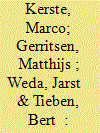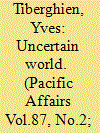| Srl | Item |
| 1 |
ID:
171883


|
|
|
|
|
| Summary/Abstract |
The advance of cryptocurrencies has sparked wide concern over their interplay with the existing global financial market. This paper analyzes the risk spillover relation between cryptocurrencies and major nancial assets, and unravels how cryptocurrencies could influence global financial systemic risk. We find that cryptocurrencies function as a separate risk source from traditional assets. Major legislative, financial and technological events in the cryptocurrency market may affect risk spillover dynamics. Although the overall penetration of cryptocurrencies is not yet deep, introducing cryptocurrency can signicantly increase the systemic risk to traditional markets during low risk level episodes
|
|
|
|
|
|
|
|
|
|
|
|
|
|
|
|
| 2 |
ID:
137726


|
|
|
|
|
| Summary/Abstract |
The credit crisis points at serious systemic risks in Over The Counter derivative trading. This has resulted in new financial regulation, covering both the financial sector and non-financial sectors. The actual extent to which non-financial companies trading on OTC markets contribute to systemic risk has hardly been the subject of research. This paper investigates the need for financial regulation in the energy sector, which shows a high use of OTC derivatives, by modeling systemic risk measured by the expected fraction of additional failing firms (EAF). Contagion risk within the energy sector and from the energy sector towards the banking sector is compared with that in other non-financial sectors. This paper adds to existing systemic risk literature by specifically looking at financial interdependence between a non-financial sector showing a high usage of OTC commodity derivatives and the banking sector, while contributing to the discussion on energy sector regulation with technical systemic risk analysis. Results indicate that contagion risk from the energy towards the banking sector is not relatively high compared to other non-financial sectors. Our results provide a first indication to question the need for generalized regulation of OTC derivative transactions, as recently introduced by the European Market Infrastructure Regulation (EMIR).
|
|
|
|
|
|
|
|
|
|
|
|
|
|
|
|
| 3 |
ID:
131066


|
|
|
|
|
| Publication |
2014.
|
| Summary/Abstract |
This article provides a response to Brantly Womack's article in this issue on a multinodal view of the global world and China's rise within it. Has globalization ushered in a new and stable structural system based on connectivity and multinodal networks?
I argue here that globalization may be more fragile and beset with system-level risk than in Womack's view. Its future depends on investment in global institutions and global governance by states and networks of private and sub-state actors. Likewise, states may increasingly be caught in networks of interconnections and dependency, while at the same time they must deal with great social forces and struggles that could yet break key links in the system. In sum, agency, political leadership, and institutions matter. The system is dynamic and interactive. It is vulnerable and dependent on active coordination. Even China's trajectory within this system can take very different paths, based on the political choices of its leaders and other players.
|
|
|
|
|
|
|
|
|
|
|
|
|
|
|
|
| 4 |
ID:
173201


|
|
|
|
|
| Summary/Abstract |
We verify the potential impact of credit-enhanced monetary policy rule on inflation, GDP and credit dynamics in Turkey (2002Q1—2018Q3), where the Turkish Cental Bank takes into account financial stability in its inflation-targeting strategy. We estimate interest rates from two monetary policy rules (classic and augmented with the exogenous credit-to-GDP gap) with time-varying parameters (TVP) and assess their performance in a TVP-VAR model. The results show that after the global crisis both observed interest rates and those estimated from the Taylor-rule impact inflation and the GDP in a similar way. The central bank’s monetary policy after 2010 was in line with the Taylor rule and took into account cyclical systemic risk with increased strength in the monetary transmission mechanism. Yet, before the crisis, both types of Taylor rules indicate that the bank’s monetary policy should have been more restrictive.
|
|
|
|
|
|
|
|
|
|
|
|
|
|
|
|